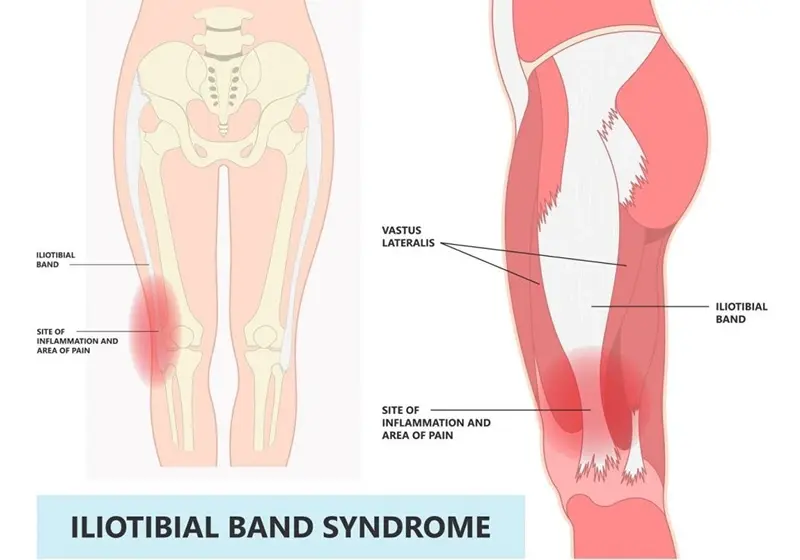Iliotibial Band Syndrome Causes & Treatment
What Is The Iliotibial Band?

Table of Contents
What Causes ITBS & Who Is At Risk?
The causes of ITBS lie in the characteristics of the iliotibial band itself, the surrounding musculature and biomechanics, as well as the activities you engage in and the associated stress on the band. You may be at increased risk if you:
- Engage in repetitive activities like running, cycling, or hiking, as these involve frequent bending and straightening of the knee, placing strain on the ITB.
- Have a tight ITB, which may occur if stretching or foam rolling has been neglected. A tight band moves more forcefully over the femoral condyle, increasing the likelihood of irritation and damage.
- Increase your running distance or intensity, as longer or more frequent sessions without adequate rest heighten the ITB’s vulnerability to overuse. Unsupportive footwear or biomechanical issues like flat feet can exacerbate this strain.
- Have weak gluteal muscles, which can lead to overactivity in the tensor fascia latae muscle, adding tension to the ITB and contributing to its tightness.
- Are recovering from a knee injury or surgery, where inactivity may weaken the surrounding structures, making them prone to strain once activity resumes.
- Have inefficient foot and leg biomechanics, where misalignment or improper movement patterns in the feet and legs can create a chain reaction that places extra stress on the ITB.
- Rely on unsupportive or worn-out footwear, which can fail to properly stabilise the feet and ankles, affecting leg biomechanics and increasing the workload on the ITB.
Proper assessment and management can help address these risk factors and prevent the onset or recurrence of ITBS
Visit Us Today
Hope Island
Phone: 07 5510 9222
Located within Hope Island Marketplace Medical & Skin Clinic, 99-103 Broadwater Ave Hope Island QLD 4212
Jimboomba
Phone: 07 5546 9766
Located Within Jimboomba Medical Centre, Unit 1/69 Cerina Cct, Jimboomba QLD 4280
Beenleigh
Phone: 07 3287 2224
Located Within Beenleigh Mall Medical Centre, Shop24A, 40/68 Main Street, Beenleigh QLD 4207
Eagleby
Phone: 07 2889 1666
Located Within Eagleby Family Practice, 5/120 River Hills Rd, Eagleby QLD 4207
Harristown
Phone: 07 4635 6111
Located Within Toowoomba Medical Centre, 146 Drayton Road, Harristown QLD 4350
Marsden
Phone: 07 3067 2370
Located Within Marsden Family Doctors, Shop 28/55-77 Chambers Flat Rd, Marsden QLD 4132
Keperra
Phone: 07 3355 4082
Located Within Keperra Medical Clinic, 14 Dallas Parade Keperra QLD 4054
Coomera
Phone: 07 5573 5663
Located Within Doctors @ Coomera Central, Shop 6, 21 Coomera Grand Drive, Upper Coomera, QLD 4209
Newtown
Phone: 07 4633 8700
Located Within Ochre Medical Centre Wyalla, Shop 20, 238 Taylor Street, Newtown QLD 4350
Signs & Symptoms Of ITBS
Treating & Preventing ITBS
- Training schedule review: By analysing and adjusting your gait patterns and training routine, we help minimise contributing factors to ITBS.
- Custom foot orthotics: These address biomechanical issues in the feet and legs that may exacerbate ITBS.
- Footwear assessment: Ensuring your shoes support healthy biomechanics and reduce undue strain.
- Physical therapy: Targeted exercises to strengthen weak muscles, such as the glutes, and stretch tight areas like the ITB.
- Hands-on treatment: Techniques such as mobilisation and dry needling to directly relieve tension in the muscles.
For initial pain management, we recommend applying ice (indirectly, for no more than 20 minutes every 1-2 hours), using non-steroidal anti-inflammatories, resting the affected leg, and avoiding movements that trigger pain.
Enquire Now
Not The Condition You Are Looking For?
Find out more about the conditions we treat by clicking below.
